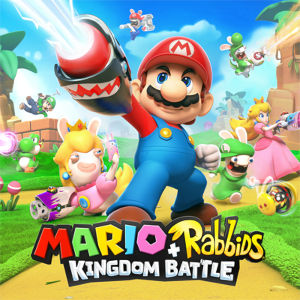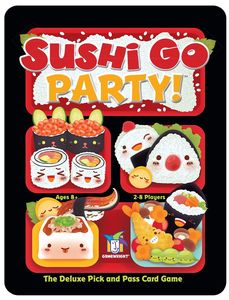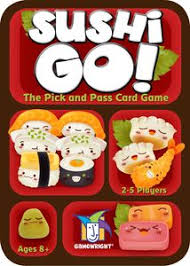
written by David Steffen
Mario + Rabbids Kingdom Battle is a turn based combat game developed for the Nintendo Switch by Ubisoft, which is a mashup of Nintendo popular Mario Bros. franchise and Ubisoft’s Raving Rabbids franchise.
A new invention has just been completed, a visor that allows the wearer to fuse two other objects into one object. Everything is going smoothly until the Rabbids arrive in the labarotory in their Time Washing Machine and start wreaking havoc, grabbing the visor among other things and fusing random things together. The inventor is a big Mario fan, so there are lots of Mario decorations around the lab, and soon the rabbid wearing the visor has fused Mario characters like Peach and Luigi with Rabbids, and the Time Washing Machine takes them all to the Mushroom Kingdom where the Rabbids are running wild, fused with various elements and monsters of the Mushroom Kingdom. It’s up to Mario, Rabbid Peach, and Rabbid Luigi to save the kingdom.
The gameplay is turn-based, and everyone is equipped with ranged weapons unique to their character and much of the game is based around finding cover from enemy fire while trying to get around the enemy cover to fire on them. You can also move every turn to change cover spots and to tackle an enemy as you go. For most rounds, the last team standing wins (different rules may apply in individual cases). To move from area to area to try to work toward saving the kingdom, they have to fight through hordes of Rabbids fused with monsters along the way.
Maybe it’s because I’m not at all familiar with the Rabbids, but I didn’t find the premise compelling. Who are the Rabbids, why do I care? But the major issue for me was that the difficulty curve was badly designed. The first battles I found too easy; I didn’t have to try very hard, just had to persevere, follow basic rules about finding cover, try to stick to the higher ground whenever possible. For several hours of gameplay this was enough, I was able to advance and didn’t die, and not only was this part not particularly challenging, it was repetitive and dull. This continued until I reached the first mini-boss battle with a more formidable foe, at which point I got soundly beaten by the mini-boss and the hordes of Rabbid minions. The earlier battles hadn’t prepared me for whatever strategies were needed to beat that tougher foe, and I was bored enough of the earlier challenges I didn’t want to go back and try to level-grind if that’s what was needed to stand a chance. I didn’t care enough about making it further in the game to really devote myself to trying over and over again to try to beat this boss, and much of that apathy was the difficulty curve of the game, which ran low low low low high without transitioning from one to the other smoothly.
Visuals
A mixture of standard 3-D Mario design with weird Rabbid looks.
Audio
Nothing remarkable.
Challenge
Very uneven challenge curve, starts out so easy that it’s boring, then ramps steeply up very suddenly.
Story
The story does not make a ton of sense, and seems to be a lot of work to justify a game mashup.
Session Time
The nice thing about the switch is you can put it to sleep at will no matter what part of the game it’s in.
Playability
Easy enough that the early battles are pretty easy to pick up. But could use some more difficulty ramp-up to prep for tougher battles.
Replayability
Even playing through the first time got boring very quickly.
Originality
While game mashups bring their own kind of originality, the gameplay itself is nothing particular original
Playtime
Unknown, didn’t get all the way through, I played for a few hours so far.
Overall
Maybe a fan of the Rabbids would be more into the game than I was, but I found the challenge progression of the game very uneven, not challenging enough at the beginning and then suddenly very challenging. I’m sure someone will find the game fun, but it’s not for me. You can find it for $60 at major retailers


